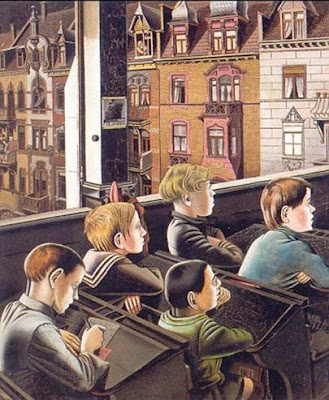Gert Wollheim, The Wounded Man, 1919
Wollheim himself was shot in the stomach and nearly died from the serious wound - and it is certain this experience was the inspiration for this disturbing work. After the war he lived in Berlin until 1919, when Wollheim, Otto Pankok (whom he had met at the academy in Weimar), Ulfert Lüken, Hermann Hundt and others created an artists' colony in Remels, (East Frisia).
At the end of 1919 Wollheim and Pankok went to Düsseldorf and became founding members of the Young Rhineland Group, which also included Max Ernst, Otto Dix, and Ulrich Leman.
Gert Heinrich Wollheim, This is the bad uncle Dix, 1923
He also became part of the aggressively political Aktivistenbund 1919 (Activist League 1919), a group of artists and intellectuals dedicated to pacifism and working class politics. Wollheim was one of the artists associated with the art dealer Johanna Ey. In 1925 he moved to Berlin, and his work began a new phase of coolly objective representation.
Gert Wollheim, Farewell from Düsseldorf, 1924
Immediately after Hitler's seizure of power in 1933 his works were declared degenerate art and many were destroyed. He fled to France and became active in the Resistance. In 1937 he was one of the joint founders of the artist federation “L´union de l'artistes libres” in Paris, and he became the companion of the dancer Tatjana Barbakoff who was murdered 1944 in Auschwitz.
Wilhelm Schmurr, The Dancer Tatjana Barbakoff, c. 1925
In Munich, three of his pictures were displayed in the defamatory Nazi exhibition Entartete Kunst (Degenerate Art) in 1937. From Paris he fled to Saarbrücken and later to Switzerland. In 1939 he was arrested and held in a labor camp until his escape in 1942, after which he hid in the Pyrénées.
Gert Wollheim, Untitled, 1926
At war's end in 1945 he returned to France, and in 1947 moved to New York and became an American citizen. He died in New York in 1974.














































